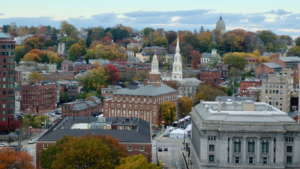By Robert Allard, Urban and Community Forestry Coordinator, Rhode Island DEM
 This year, as families all over the country spend more time at home, we have been given the opportunity to appreciate the fresh air that we can enjoy on our own back porches and front stoops more than ever. Trees are a significant factor contributing to the quality of the air we breathe. Recent research shows that even relatively small trees bring benefits to their neighborhoods. Just a single tree has the potential to filter up to one third of fine particulates such as dust, dirt, soot, and smoke within 300 yards, and can reduce particulate matter inside homes by as much as 60%.
This year, as families all over the country spend more time at home, we have been given the opportunity to appreciate the fresh air that we can enjoy on our own back porches and front stoops more than ever. Trees are a significant factor contributing to the quality of the air we breathe. Recent research shows that even relatively small trees bring benefits to their neighborhoods. Just a single tree has the potential to filter up to one third of fine particulates such as dust, dirt, soot, and smoke within 300 yards, and can reduce particulate matter inside homes by as much as 60%.
Trees contribute to cleaner air by absorbing gaseous pollutants through leaf stomata and intercepting particulate matter such as carbon monoxide, nitrogen dioxide, ozone, lead, sulfur dioxide, and other small particles that can impact human health. Even with the variability in absorption among species, the emission of volatile organic compounds (VOCs), and pollen production, trees have an overall positive impact on human health.
Unfortunately, not everyone has the opportunity to live near, around, or adjacent to trees. Low income communities are disproportionately impacted by a lack of green space and trees. A recent study on racial-ethnic disparities in air pollution exposure found that most fine particulate matter air pollution is due to the consumption of goods and services, and many people are living with air pollution that their community is not proportionately responsible for. The study noted: “On average, non-Hispanic whites experience a “pollution advantage”: They experience ~17% less air pollution exposure than is caused by their consumption. Blacks and Hispanics on average bear a “pollution burden” of 56% and 63% excess exposure, respectively, relative to the exposure caused by their consumption.”
Trees are an accessible and relatively affordable way to improve climate resiliency, human health, and quality of life. By supporting programs that work towards “tree equity” for underserved neighborhoods, the urban and community forestry field can help provide clean, healthy air to communities nationwide.
This post is part of the NMSFA Healthy Trees Healthy Lives Campaign. Please share on social media and with partners with the hashtag #healthytreeshealthylives.
